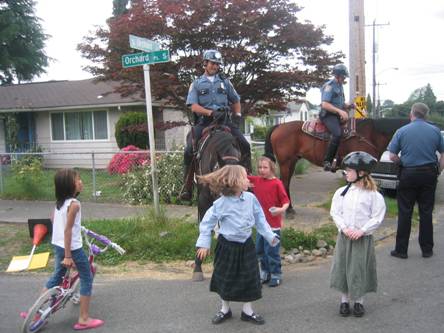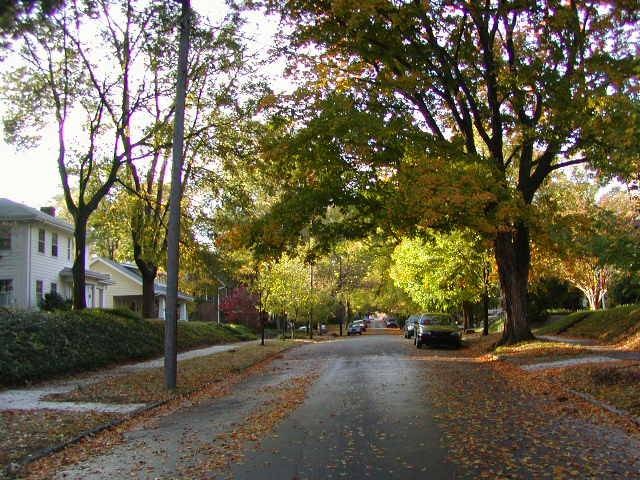Crime Prevention Through Environmental Design (CPTED, or “sep-ted”) is an approach to deterring criminal behavior through the effective design and use of the built environment. The objective of such approach is to encourage a reduction in the fear of crime, a reduction in the actual number of crimes, an improvement in community safety, an improvement in the perception of safety, and an improvement in the overall quality of life in a community. CPTED strategies are proven to influence offender decisions that precede criminal acts, thereby detering criminal activity.
Why is this important to your community?
Crime is an issue that virtually every community faces to varying degrees. While community policing—the implementation of strategies that proactively address conditions that lead to public safety issues—by residents and law enforcement will always be necessary to prevent crime, the design of the built environment can have an important influence in deterring criminal activity by ensuring that there are “eyes on the street” and by passively regulating natural access in and out of spaces. Designing both the public and private realms using CPTED principles is a relatively simple and cost-effective improve safety in almost any environment, from buildings and parking structures to streets and parks. And when people feel safe in public spaces such as parks and civic plazas, they are more likely to use them, and build community by getting to know their neighbors and fellow users of the spaces.
Where is it appropriate to use?
What priorities does it address?
What other tools are related?
- Active Living
How does it work?
The CPTED approach is grounded in four principles:
- Natural Surveillance: Natural surveillance occurs by designing the placement of physical features, activities and people in such a way as to maximize visibility and foster positive social interaction among legitimate users of private andpublic space. Potential offenders feel increased scrutiny and limitations on their escape routes. The goal is to “see and be seen.” Examples include windows overlooking sidewalks, security lighting, open stairways, and reducing visual obstructions.
- Natural Access Control: Natural access control occurs by utilizing walkways, fences, lighting, signage, and landscape to limit access, control flow, and clearly guide people and vehicles to and from their proper entrances. The goal is not necessarily to keep intruders out, but to direct the flow of people and clearly differentiate between public and private space. Design techniques include clearly marked public walkways, limiting the number of entrances and exits to buildings, and using wayfinding (e.g., signage, lights, etc.) to guide people along public streets and paths.
- Natural Territorial Reinforcement: Natural territorial reinforcement occursthrough increased definition of space and improved proprietary concern. An environment designed to clearly delineate private space does two things. First, it creates a sense of ownership. Owners have a vested interest and are more likely to challenge intruders or report them to the police. Second, the sense of owned space creates an environment where "strangers" or "intruders" stand out and are more easily identified. By using buildings, fences, pavement, signs, lighting and landscape to express ownership and define public, semi-public, and private space, natural territorial reinforcement occurs. Territorial reinforcement measures make the normal user feel safe and make the potential offender aware of a substantial risk of apprehension or scrutiny. When people take pride in what they own and go to the proper measures to protect their belongings, crime is deterred from those areas because now it makes it more of a challenge. The more difficult it is to commit a crime in certain areas, the less crime will occur. Some examples of Territorial Reinforcement include utilizing landscaping to clearly delineate public and private, posting a guard or installing security cameras as particular entrances, or defining property lines clearly with a small fence.
- Maintenance: Maintenance is an expression of “ownership” of property. Deterioration indicates less control by the intended users of a site and indicate a greater tolerance of disorder. This principle is influenced by the Broken Windows Theory, which maintains that the presence of a broken window (or other kind of vandalism such as graffiti) will entice vandals to break more windows in the vicinity. The sooner broken windows are fixed, the less likely it is that such vandalism will occur in the future. Having a positive image in the community shows a sense of pride and self-worth that can help deter future criminal activity. The Maintenance principle can be achieved by regularly removing graffiti and other trash, repairing structures in disrepair, and ensuring that landscaping is well-maintained (e.g., cut grass and weeds and keep trees and shrubs trimmed).
In newly contructed buildings, communities, or parks/open spaces, designs can and should reflect best practices in CPTED and generally do not add to construction costs. In some cities with “defensible space” ordinances, CPTED strategies may be required as part of the development code. Depending on existing conditions, retrofitting spaces to CPTED strategies can be costly, although they can help reduce the overall cost of security operations and law enforcement in the long term.
While designing and retrofitting spaces using CPTED strategies can be an effective way to help reduce criminal activity in a community, they must be part of a multi-pronged approach that includes effective law enforcement and active community policing. Natural surveillance and property maintenance (CPTED Principles 1 and 4), for example, rely partly on the will and resources of the community by urging community members to stay alert in public spaces and maintain their own property, making the responsibility of crime deterrence a community-wide effort. In addition to community support, consistant maintenance of public spaces, including parks and recreation facilities, by municipal departments is required to ensure the CPTED principles are successful.
Resources
- LISC Community Safety Initiative
- Design Center for CPTED
- New Energy for Urban Security: Improving Urban Security Through Green Environmental Design, United Nations Integrated Crime and Justice Research Institute
- Crime Prevention Through Environmental Design: Guidelines for Queensland, Part A: Essential Features of Safer Places
- Crime Prevention Through Environmental Design: Guidelines for Queensland, Part B: Implementation Guide
- Crime Prevention Through Environmental Design: Durham Guide to Creating a Safer Community, Durham County, NC
- Crime Prevention Through Environmental Design: General Guidelines for Designing Safer Communities, City of Virginia Beach, VA
- Crime Prevention Through Environmental Design: A guide to safe environments in Prince William County, Virginia
- Safe Growth and CPTED in Saskatoon: CPTED Guidelines
Ready to get started?
Using the Tool
- Develop and adopt CPTED guidelines that local municipalities, developers, and designers can use as a resource when designing new neighborhoods, parks, and structures. Where design review is required, encourage the use of CPTED strategies in new projects. Look at local best practices (e.g., parks with high use and low crime rates) to see what design features and amenities encourage high useage by the community.
- Consider adopting a “defensible space” ordinance as part of the local development code that explicitly requires the use of CPTED strategies in the design of new projects. Such an ordinance could also require retrofitting of spaces during major renovations where safety conditions in the built environment need improvement. Feasibility and cost should be factors in any retrofit requirements.
- Collaborate with local communities
- Where crime is a persistent issue, work with residents to identify factors in the built environment that may be contributing to criminal activity
- Engage residents, community organizations, law enforcement, city agencies, local businesses, and others to design programs that foster community pride, ownership, and solidarity.
Partners
- Architects
- Colleges and Universities
- Community Development Organizations
- Departments of Education / School Districts
- Developers
Where has it worked?
Nevin Park - Richmond, CA
 Image Source: City of Richmond California.
Image Source: City of Richmond California.
Contact
Cheryl Maier, Executive Director
Opportunity West
510-236-5812
opportunitywest@sbcglobal.netMichelle Milam, Crime Prevention Coordinator
Richmond Police Department
510-620-6538
mmilam@richmondpd.netAbout the Program
Nevin Park is located in the Iron Triangle neighborhood of Richmond, California, a working-class community on the northeast corner of the San Francico Bay. Economically stressed and geographically isolated from other neighborhoods by freight tracks, the Iron Triangle is also Richmond’s highest crime neighborhood. Prior to its renovation in 2008, Nevin Park was a center for criminal activity such as drug dealing and prostitution in the neighborhood, and as a result, families and children were deterred from using it despite the large number of youth living in close proximity. One primary issue of concern was the design of the park, which created spaces that concealed criminal activity and provided less community control over the space. Transformation of Nevin Park and the neighboring Nevin Park Community Center was spearheaded by coalition of citizen groups such as Building Blocks for Kids Collaborative, community organizations such as Opportunity West, and City agencies that, in 2005, launched a revitalization project called “Eyes on the Park” that enganged the community to solicit feedback for the redesign of the park. A number of changes and upgrades were made utilizing CPTED principles:
- A four-foot permeable fence was installed around the new children’s playground and basketball courts that provided better access control to the park and allowed it to be closed off at night.
- Earth mounds, retaining walls, and some trees were removed and the entire park was levelled to provide better sightlines across the park. As a result, parents can observe their kids from all vantage points, neighbors can provide “eyes on the street,” and law enforcement officers can easily spot criminal activity.
- Picnic benches, barbeque pits, and seating areas were installed to encourage positive use of the park.
- A new glass entrance from Nevin Park was installed in the Nevin Park Community Center, which looks out over the renovated park, easing supervision for community center staff.
Why it works
The physical improvements to Nevin Park transformed it from a site of frequent criminal activity to a public resource for children, youth, and families. The park and community center are now community hubs for activities like job training, fitness classes, after school sports, and community celebrations. While violent crimes still occur in the Iron Triangle, they decreased by 55% between 2005 and 2010. Just as important as the physical improvements, however, is the investment that residents, community organizations, and law enforcement officials have made to become actively involved in community policing. The most successful community safety and revitalization strategies are those that invest in both the built environment and in the local residents themselves.
“Community Input and Participation Help Revitalize the Park: Building Blocks for Kids and the Richmond Police Department,” LISC Community Safety Initiative, 2010
CPTED - Greensboro, NC
About the Program
The City of Greensboro, North Carolina, in an effort to increase community safety and security, instituted a city-wide CPTED assessment for homes and businesses. The program gives residents and business owners access to a free personalized security assessment of their home, apartment, or business with a Community Resource Officer—a police officer trained in CPTED principles. The Community Resource Officer educates residents and business owners about the four principles of CPTED (Natural Surveillance, Natural Access Control, Territoriality,and Broken Windows Theory).
Why it works
By engaging the community in preventative measures, Greensboro has encouraged a community-wide approach to ehancing safety. The Community Resource Officer provides residents and business owners with simple tips to reduce the likelihood of crime or vandalism. Some of these strategies include trimming back trees and bushes, putting the most comfortable chairs by windows to encourage ‘eyes on the street’, and restrict access so that people have a limited number of ways in and out. The Greensboro Police Department also provides assistance incorporating CPTED principles in the design of larger projects including Greensboro’s Downtown Greenway.
http://www.greensboro-nc.gov/index.aspx?page=36&recordid=3070&returnURL=%2Findex.aspx
Rainier Valley - Seattle, WA
 Image Source: HomeSight.
Image Source: HomeSight.
Contact
Sarah Valenta, Coordinator
HomeSight CSI
206-723-4355
sarah@homesightwa.orgAbout the Program
Rainier Valley is a culturally and economically diverse neighborhood in Southeast Seattle that was challenged for many years with drug- and gang-related crime. In 2003, HomeSight, a local community development corporation, teamed with the resident-led Rainier Othello Safety Association (ROSA), and the Seattle Police Department (SPD) on the “Curbing Crime, One Street at a Time” project to tackle the issue of pervasive criminal activity in the neighborhood with a special focus on a few high crime streets and intersections such as Rainier and Othello Streets. As one element of their overall approach, they identified CPTED strategies to implement small-scale projects that would have significant crime-prevention impacts. These included reorienting a bus shelter toward the street so that that it no longer served as a concealed space for drug trading and prostitution; adding streetscape amenities like planters, banners, and a community news kiosk designed by a local artist at the intersection of Rainier and Othello; and adding curbs to a nearby residential street where drivers routinely parked their cars on the sidewalk and where debris accumulated in the grassy gulley between the street and sidewalk. The curbing normalized street parking, which in turn caused traffic to move slowly and increased physical safety for both pedestrians and motorists. Litter was reduced, helping to bolster residents’ sense of pride and ownership. The results were so positive that ROSA was successful in securing funds to expand the curbing to two parallel streets.
These and other physical design improvements were combined with neighborhood engagement and programming efforts such as resident-led crime walks, a yearly “Bicycle Safety Day” that closed off vehicular access on several neighborhood streets, and a yearly concert series at a local park that connected residents and helped them reclaim their neighborhood. Despite an intial spike in crime reported to the SPD in the year following the program’s initiation— which the police attributed to an increase in crime reporting by residents rather than an actual increase in criminal activity—by 2006 drug-related crime dropped 20 percent.
Why it works
Rainier Valley’s “Curbing Crime, One Street at a Time” project provides a successful example of combining physical design improvements with community engagement and cooperation to deter crime and encourage a sense of community responsibility for the neighborhood. Overcoming initial skepticism about working with the SPD, ROSA found a willing partner in the local precinct police force, which set the stage for a highly collaborative relationship for building trust between the police and residents. With HomeSight, ROSA, SPD, and residents working together, it was possible to secure funding and implement needed physical improvements. The new kiosks, banners, planters, and curbs created a stronger sense of place, which in turn encouraged residents to come out and participate in community-oriented events. The events fostered a sense of community while restoring ownership of the parks and streets from drug dealers and gangs to law-abiding community members. Even though each of the individual projects took its own approach to promoting community safety, together, the projects created something much greater than any individual improvement—a sense of pride, and an invitation for all residents to help create a safer neighborhood.
“Curbing Crime, One Street at a Time: HomeSight and the Seattle Police Department,” LISC Community Safety Initiative, 2007
- Colleges and Universities



